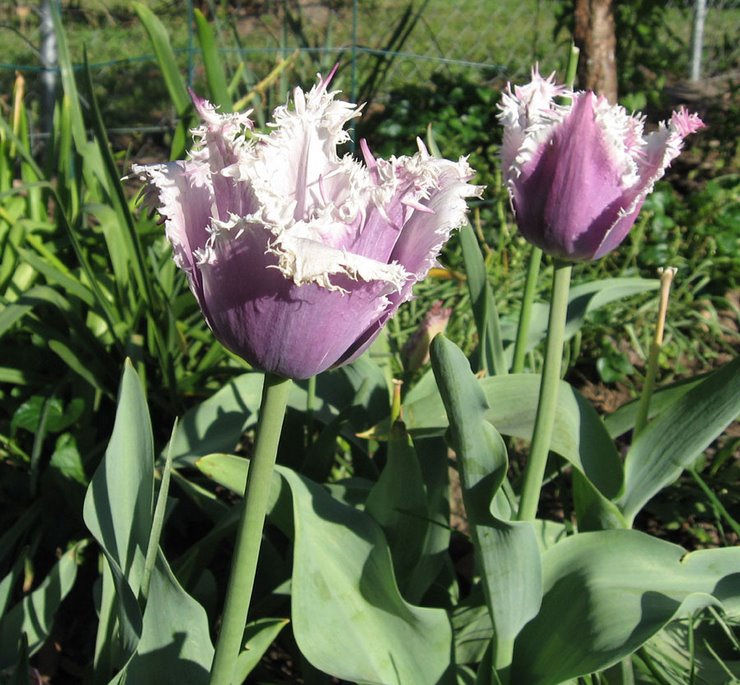 |
| Baby tomatoes |
Friday, May 31, 2013
Early Tomatoes
Thursday, May 30, 2013
Dog's Allergies
Wednesday, May 29, 2013
Setting up the Garden Fountain
Last evening I got my little outdoor fountain out of winter storage and set it up for the summer. I love the sound of splashing water, and it attracts lots of birds to a garden. My fountain spends its summer bubbling away beside the front porch, where I can enjoy it when I sit outside there, or as I come and go from the front door.
Tuesday, May 28, 2013
Anticipation Fulfilled
 | |
| Wisteria covering south fence |
This is the third year for my wisteria vine, and the first time when it has put on such a wonderful display of flowers. Last year it only had a half dozen blossoms.
Monday, May 27, 2013
Memorial Day
 |
| White peonies |
Sunday, May 26, 2013
Getting a Start on Vertical Gardening
When a garden has only limited space, one way to make the most of every inch is to support vining plants to grow up rather than to sprawl across the ground. I've learned so much from the the wonderful Square Foot Gardening books by Mel Bartholomew. He has some great suggestions for making the most of small garden areas, and the close placement of plants in a series of small beds.
Saturday, May 25, 2013
Eggshells for the Garden
Another of the things from my kitchen that I save for use in the garden is eggshells. I rinse them well, and save them in a plastic bag until I have enough to bother with (or feel the need for them). Then I use a rolling pin to crush them while they're still in the bag. You want them crushed pretty well to a powder. You could also put the shells in a plastic bucket and grind them with the bottom of a glass jar or another hard object as a make-shift mortar and pestle.
Labels:
birds,
compost,
vegetable gardening,
worm composting
Thursday, May 23, 2013
First Compost of the Year
I've checked on my two compost tumblers occasionally the last several weeks. The last time I filled them was in the fall. Over the winter, cold weather brings the composting process to a halt. This spring I resumed turning them about every day, and waited for the compost to be done. Once you can no longer recognize what the original materials were, and it just looks and smells like a nice, dark garden soil, it's ready to use.
Wednesday, May 22, 2013
Edible Garden Update
 |
| Strawberries in stacking planter |
Labels:
herbs,
vegetable gardening,
volunteer vegetables
Tuesday, May 21, 2013
Anticipation
 |
| Wisteria bud |
Monday, May 20, 2013
Tornado Season in Kansas
 |
| Hosta flattened by heavy rain |
Saturday, May 18, 2013
First Peonies of the Year
 | |
| Tree Peony |
Thursday, May 16, 2013
Summer Garden Re-Runs
 |
| Moss rose seedlings |
For example, I was working in the flower bed out front by the street last evening. Moss rose, or portulaca, was growing there last year, and I know it reseeds. I kept a careful eye out as I pulled out grass and weeds, and sure enough, there were the tiny little seedlings of the moss rose, just starting to grow.
Wednesday, May 15, 2013
War on Weeds: Chickweed
 | |
| Chickweed |
Tuesday, May 14, 2013
Results on Overwintering Plants
 |
| Pop-up greenhouse |
This greenhouse is just a layer of heavy plastic, and is unheated, so it has been an interesting experiment to see what difference it could make in helping plants survive the winter.
Monday, May 13, 2013
War on Weeds: Prickly Lettuce
 |
| Prickly lettuce (large plant in center) |
Sunday, May 12, 2013
Friday, May 10, 2013
Fruit Peels for the Garden
 |
| Fresh fruit -- good for me, and for my garden |
I could also put the chopped peels into the compost bin, or the worm bin, but I enjoy this relaxed moment among the flowers.
Thursday, May 9, 2013
Just Starting to Bloom
 |
| Bearded iris beginning to bloom |
Tuesday, May 7, 2013
Favorite Flowers: Creeping Phlox
 |
| Creeping phlox |
Perennial, zones 3-9
Full sun to light shade, 2-6" tall
One of the flowers that adds so much color to the spring garden is creeping phlox, also known as moss pinks. In the spring, when it blooms, it is literally covered with small flowers for several weeks. When grouped together or allowed to spread as a groundcover, this mass of color is stunning. Creeping phlox blooms in pink, rose, lavendar, blue, white or variegated. Even when the flowering is over, the needle-like foliage, evergreen in milder climates, makes a nice thick ground cover.
Sunday, May 5, 2013
War on Weeds: Henbit
 |
| Henbit |
Henbit prefers cool, moist soil, so it flourishes in the spring. It usually grows to about 6 inches tall. Its seeds germinate in the fall, live through the winter, and then grow and flower in the spring. As temperatures start to rise, it dies, leaves lots of seeds for fall. Henbit spreads primarily by seed, though the stems can root where they touch the soil.
Friday, May 3, 2013
Winter Sowing Update
 |
| Parsley seedlings grown outdoors in a milk jug |
Labels:
propagation,
spring planting,
starting seeds,
winter sowing
Thursday, May 2, 2013
Snow in May
 |
| Snow on the daffodils |
Wednesday, May 1, 2013
Subscribe to:
Posts (Atom)
Fringed Tulips





